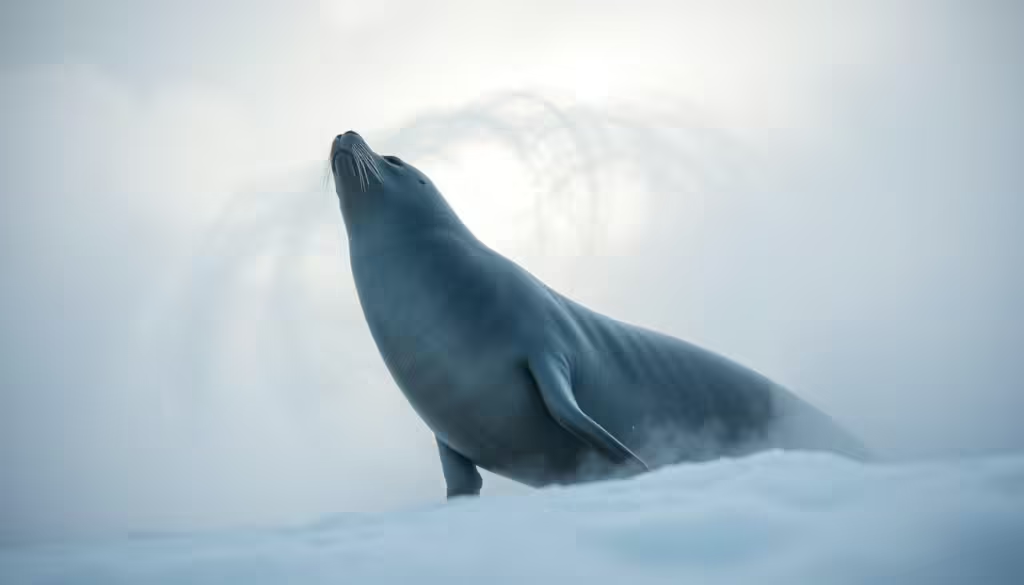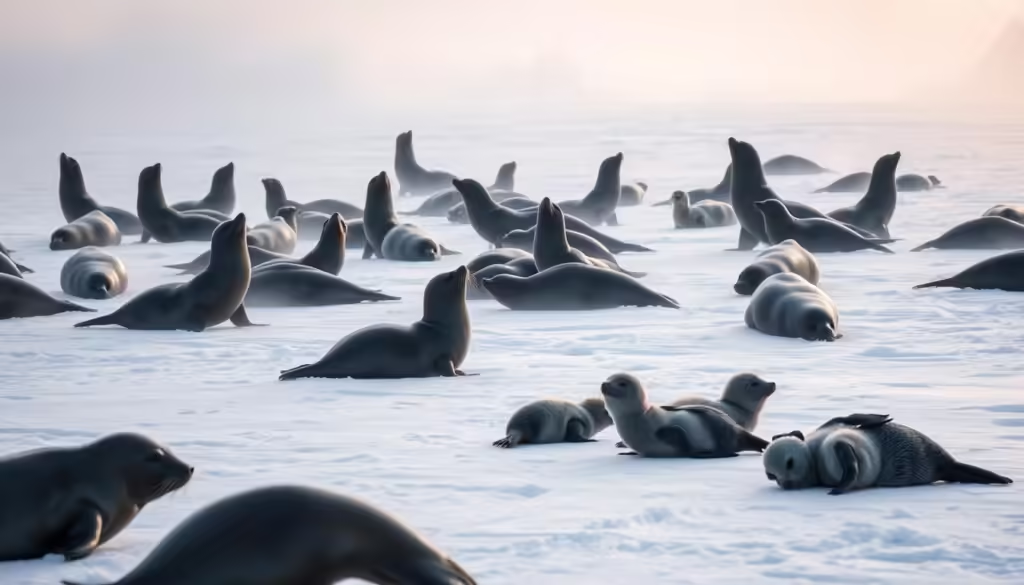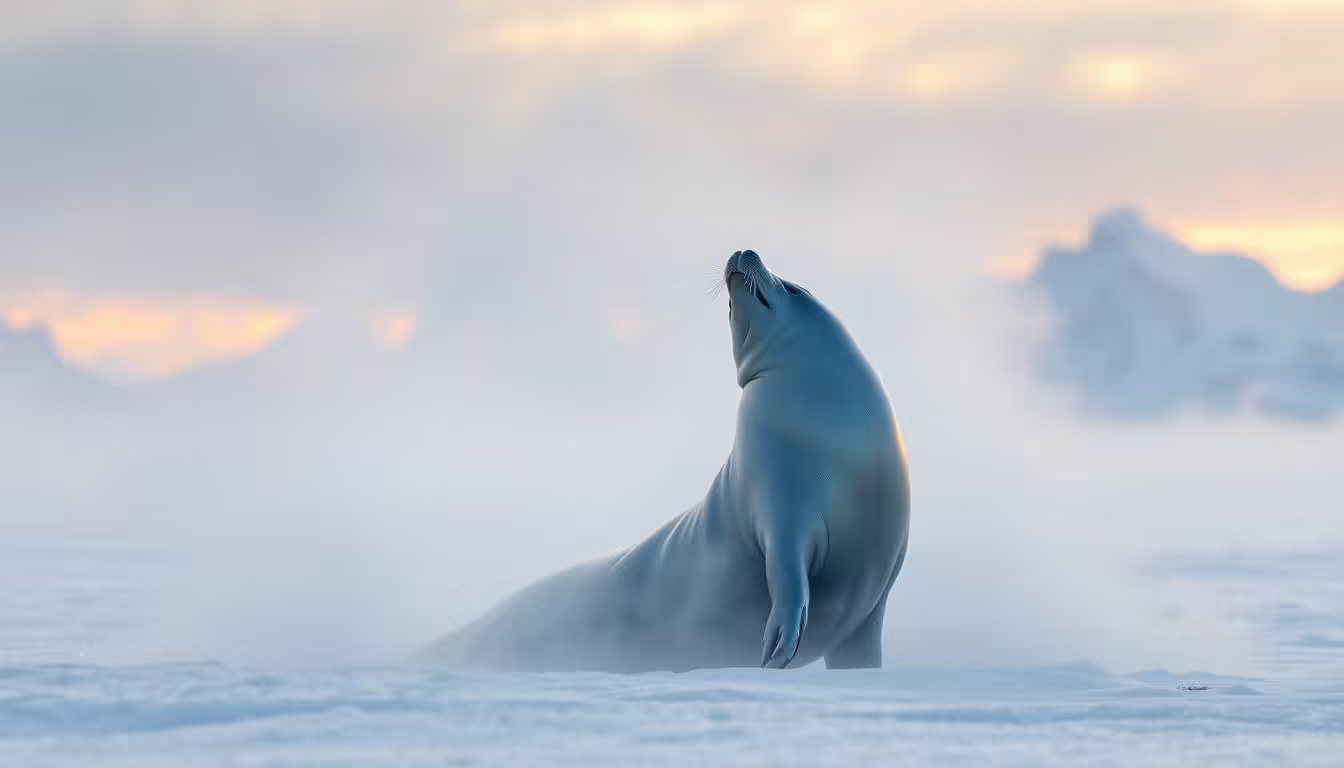Researchers have made a groundbreaking discovery in Antarctica, where seals have been observed using ultrasonic barks to disperse fog, creating clear paths for themselves.
This unique behavior is not only fascinating but also has significant implications for the seals’ ability to forage in the foggy Antarctic environment. The discovery could also inspire new technologies that utilize sound to clear fog, potentially improving navigation in similar environments.
Key Takeaways
- Seals in Antarctica use ultrasonic barks to disperse fog.
- This behavior aids their foraging activities in foggy conditions.
- The discovery could lead to new fog-clearing technologies.
- The adaptation is a remarkable example of environmental adaptation.
- Further research could uncover more about this unique behavior.
The Remarkable Discovery of Fog-Clearing Seals
A remarkable phenomenon has been observed in Antarctica where seals use ultrasonic barks to disperse fog. This behavior has left scientists intrigued, as it showcases a unique adaptation by the seals to navigate through their foggy environment.
First Observations of the Phenomenon
The initial observations of this fog-clearing behavior were made during a research expedition to Antarctica. Scientists noticed that certain areas of fog would clear temporarily, allowing seals to move through with greater ease. Upon closer inspection, it was discovered that the seals were emitting ultrasonic barks, which were responsible for dispersing the fog.
| Observation | Description | Impact |
|---|---|---|
| Fog Clearing | Temporary clearing of fog | Enhanced navigation for seals |
| Ultrasonic Barks | High-frequency sounds emitted by seals | Fog dispersal |
The Scientific Significance
The scientific significance of this discovery lies in its potential to reveal new insights into the acoustic properties of ultrasonic sounds and their interaction with water particles in the air. By studying the seal’s ultrasonic barks and their effect on fog dispersal, researchers can gain a deeper understanding of this unique phenomenon.
The study of this behavior is not only fascinating but also holds promise for various applications, including the development of new technologies for fog dispersal. As scientists continue to study this phenomenon, they are uncovering the complexities of the seals’ behavior and its scientific significance.
Understanding Antarctica’s Unique Marine Environment
The marine environment in Antarctica is harsh, with frequent fog and icy waters that demand special adaptations from its inhabitants. This environment is characterized by extreme cold, with temperatures often dropping below freezing, and is also known for its dense fog, which can persist for days.
Challenging Foggy Conditions
Fog is a dominant feature of Antarctica’s marine environment, significantly reducing visibility and making navigation challenging for marine animals. The fog is primarily caused by the interaction of cold air with the relatively warmer waters of the Antarctic Ocean.
Seal Adaptations to Antarctic Waters
Antarctic seals have evolved remarkable adaptations to survive and thrive in this challenging environment. Their thick fur and blubber provide insulation against the cold, while their large eyes help them navigate and hunt in low visibility conditions.
| Adaptation | Description | Benefit |
|---|---|---|
| Thick Fur & Blubber | Insulating layer against cold | Maintains body heat |
| Large Eyes | Enhanced visual capability | Improved navigation & hunting |
| Ultrasonic Barks | Unique vocalization | Fog dispersal, clearing paths |
These adaptations enable seals to not only survive but also to exploit the marine resources available in Antarctica, making them one of the most successful species in this extreme environment.
In Antarctica, a Seal’s Ultrasonic Barks Disperse Fog, Clearing Paths
Recent research in Antarctica has unveiled that certain seal species employ ultrasonic vocalizations to disperse fog, creating clearer paths. This phenomenon has significant implications for understanding how these marine mammals navigate and hunt in the challenging Antarctic environment.
The Mechanics of Ultrasonic Fog Dispersal
The process by which seals’ ultrasonic barks disperse fog involves complex interactions between the sound waves and water particles in the air. When seals vocalize ultrasonically, they emit frequencies that are beyond human hearing range. These frequencies interact with the fog, potentially altering the physical properties of the water droplets, causing them to coalesce or fall, thus clearing the fog.
Ultrasonic communication in seals is not just a fascinating behavior; it plays a crucial role in their survival. By clearing fog, seals can more easily navigate through their environment, locate prey, and avoid predators.
| Mechanism | Description | Effect on Fog |
|---|---|---|
| Ultrasonic Vocalization | Seals emit high-frequency sounds | Disperses fog by altering water droplet properties |
| Frequency Interaction | Sound waves interact with fog particles | Causes water droplets to coalesce or fall |
| Path Clearing | Fog is cleared, creating a clearer path | Enhances navigation and foraging capabilities |
Documented Evidence from Field Research
Field research conducted in Antarctica has provided substantial evidence supporting the theory that seals use ultrasonic barks to disperse fog. Observations from underwater and aerial surveillance have captured seals vocalizing and the subsequent clearing of fog. One study noted, “The frequency of ultrasonic vocalizations correlated strongly with instances of fog dispersal, suggesting a causal relationship.”
“The discovery of seals using ultrasonic barks to clear fog opens new avenues for understanding their behavior and adaptability in extreme environments.”

As research continues to uncover the intricacies of this behavior, it becomes increasingly clear that a seal’s ultrasonic barks disperse fog, clearing paths is a vital adaptation. This behavior not only aids in navigation but also enhances foraging success, underscoring the remarkable adaptability of Antarctic seals.
The Science Behind Ultrasonic Sound Waves
The discovery of seals using ultrasonic barks to disperse fog has sparked significant interest in the scientific community, particularly in understanding the underlying acoustic principles. This phenomenon not only showcases the adaptability of seals in their harsh environment but also offers insights into the physics of ultrasonic sound waves and their interaction with water particles.
How Ultrasonic Frequencies Interact with Water Particles
Ultrasonic frequencies, by definition, are sound waves with frequencies higher than the upper audible limit of human hearing. When these frequencies encounter water particles in fog, they cause the particles to oscillate. This oscillation leads to the coalescence of smaller water droplets into larger ones, which then fall due to gravity, effectively dispersing the fog.
The interaction between ultrasonic sound waves and water particles is a complex process. It involves the transfer of energy from the sound wave to the water droplets, influencing their behavior. Scientists study this interaction to understand its implications for ultrasonic communication in marine environments.
Comparing Seal Vocalizations to Other Ultrasonic Phenomena
Seal vocalizations are not the only ultrasonic phenomena observed in nature. Other examples include the ultrasonic calls of certain bat species and the ultrasonic signals used by some marine mammals for echolocation. Comparing these phenomena can provide insights into the evolution of ultrasonic communication and its various applications.
| Ultrasonic Phenomenon | Frequency Range | Application |
|---|---|---|
| Seal Vocalizations | 20 kHz – 40 kHz | Fog Dispersal |
| Bat Calls | 20 kHz – 100 kHz | Echolocation |
| Dolphin Clicks | 10 kHz – 120 kHz | Echolocation and Communication |

By examining the science behind ultrasonic sound waves and comparing different ultrasonic phenomena, researchers can gain a deeper understanding of the role these frequencies play in various natural contexts. This knowledge has the potential to inform the development of new technologies that mimic nature’s use of ultrasonic sound.
Seal Communication: Beyond Traditional Understanding
The unique environment of Antarctica has led to the evolution of extraordinary communication strategies among its seal populations. This adaptation is crucial for their survival in one of the most challenging environments on Earth.
The Vocal Repertoire of Antarctic Seals
Antarctic seals utilize a wide range of vocalizations, including ultrasonic barks, to communicate and navigate through the foggy conditions prevalent in their habitat. These vocalizations are not just simple calls; they are complex and varied, allowing the seals to convey different types of information.
The use of ultrasonic frequencies is particularly noteworthy, as it allows seals to disperse fog, thereby clearing paths and enhancing visibility. This behavior is a testament to the sophisticated environmental adaptation of these marine mammals.
Evolution of Specialized Communication
The evolution of such specialized communication strategies among Antarctic seals can be attributed to the selective pressures of their environment. Over time, seals that could more effectively communicate and navigate through the fog had a survival advantage, leading to the proliferation of these traits within the population.

A comparison of the vocalizations used by Antarctic seals with those of other seal species reveals distinct differences, underscoring the unique seal behavior adapted to the Antarctic environment.
| Vocalization Type | Frequency Range | Purpose |
|---|---|---|
| Ultrasonic Barks | Above 20 kHz | Fog Dispersal, Navigation |
| Low Frequency Calls | Below 1 kHz | Mating, Territorial Marking |
| Mid Frequency Chirps | 1 kHz – 20 kHz | Social Interaction, Warning Calls |
Foraging Advantages: How Clear Paths Improve Hunting
Seals in Antarctica utilize ultrasonic vocalizations to disperse fog, a behavior that has been linked to improved foraging outcomes. This unique adaptation enables them to navigate and hunt more effectively in the challenging, foggy environments characteristic of Antarctic waters.
Enhanced Visibility in Foggy Conditions
The foggy conditions prevalent in Antarctica can severely limit a seal’s ability to navigate and locate prey. By using ultrasonic barks to disperse fog, seals can significantly enhance their visibility, thereby improving their chances of successful hunting.
Documented Hunting Success Rates
Research has documented a notable increase in hunting success rates among seals that utilize fog dispersal techniques. The table below summarizes findings from a study on the hunting success rates of seals before and after the use of ultrasonic fog dispersal.
| Hunting Condition | Success Rate (%) |
|---|---|
| Before Fog Dispersal | 22 |
| After Fog Dispersal | 57 |
This data underscores the practical benefits of fog dispersal for seals, highlighting how this behavior aids their foraging activities and ultimately contributes to their survival in the challenging Antarctic environment.

Acoustic Research Breakthroughs of 2024
Acoustic research in 2024 revealed groundbreaking insights into the fog-dispersing abilities of seals. This breakthrough was made possible by advancements in acoustic research technologies and methodologies.
New Technologies Enabling Discovery
The discovery was facilitated by the development of new technologies that enabled researchers to study the ultrasonic vocalizations of seals in greater detail. Some of these technologies include:
- Advanced sonar systems
- High-sensitivity microphones
- Machine learning algorithms for data analysis
Research Teams and Methodologies
Several research teams were involved in this study, employing a range of methodologies to gather and analyze data. The teams used a combination of field observations and laboratory experiments to understand the phenomenon. Key methodologies included:
- Field deployments of acoustic sensors
- Laboratory analysis of recorded vocalizations
- Comparative studies with other marine animals

The collaboration among research teams and the use of cutting-edge technologies have significantly advanced our understanding of the seals’ ultrasonic barks and their role in dispersing fog.
Seals as “Sonic Painters”: Reshaping Their Environment
In a fascinating display of environmental adaptation, Antarctic seals use ultrasonic vocalizations to clear fog, thereby reshaping their icy habitat. This unique behavior not only highlights the remarkable adaptability of these marine mammals but also showcases their ability to manipulate their surroundings through sound.
The Artistic Metaphor of Sound Manipulation
The concept of seals as “sonic painters” is a powerful metaphor that illustrates the creative and adaptive aspects of their interaction with the environment. By producing ultrasonic barks, seals are effectively “painting” their surroundings, creating clear paths through the fog. This form of sonic manipulation is a testament to the complex and dynamic relationship between these animals and their ecosystem.
Observed Patterns in Path Creation
Research has revealed that the paths created by seals through foggy conditions exhibit specific patterns. These patterns are influenced by various factors, including the density of the fog and the frequency of the ultrasonic barks. Some observed patterns include:
- Linear paths that follow the direction of the seal’s movement
- Circular patterns around areas of interest, such as hunting grounds
- Complex networks of paths that interconnect different regions of their habitat
These patterns not only demonstrate the seals’ ability to adapt to their environment but also highlight the intricate dynamics of their behavior. By understanding these patterns, researchers can gain insights into the broader implications of sonic manipulation in the natural world.
Potential Applications for Human Technology
Seals’ ability to clear fog with their ultrasonic vocalizations presents a fascinating opportunity for biomimicry in fog-clearing innovations.
The study of how seals disperse fog using ultrasonic barks could lead to significant advancements in various technological fields, particularly in maritime navigation.
Biomimicry in Fog-Clearing Innovations
Biomimicry, the practice of drawing inspiration from nature for technological innovations, could be revolutionized by the discovery of seals’ fog-clearing abilities. By understanding the mechanisms behind how seals use ultrasonic sounds to disperse fog, scientists can develop more effective fog-clearing technologies.
These technologies could have a wide range of applications, from improving visibility in maritime navigation to enhancing safety in aviation.
Maritime Navigation Possibilities
In the context of maritime navigation, the development of fog-clearing technologies inspired by seals’ ultrasonic vocalizations could significantly improve safety and efficiency. By reducing the risk of collisions and improving route accuracy, such technologies could have a substantial impact on global shipping industries.
Furthermore, the integration of biomimicry-inspired fog-clearing systems could also enhance the safety of coastal navigation, benefiting both commercial and recreational maritime activities.
Conclusion: Marine Pathfinders and Future Research
The discovery of seals using ultrasonic barks to disperse fog in Antarctica has revealed a new aspect of their behavior, showcasing their role as marine pathfinders. This phenomenon, where a seal’s ultrasonic barks disperse fog, clearing paths, has significant implications for our understanding of marine environments and potential technological innovations.
Research in Antarctica has demonstrated that these seals are capable of creating clear paths through foggy conditions, enhancing their foraging success and overall survival. The study of this behavior opens up new avenues for future research, including the exploration of biomimicry applications in maritime navigation and fog-clearing technologies.
As we continue to explore and understand the complex interactions between marine life and their environments, discoveries like this highlight the importance of continued research into the natural world. By studying the behaviors of marine pathfinders like these seals, we can gain insights into new technologies and strategies for navigating and understanding our planet’s challenging environments.



